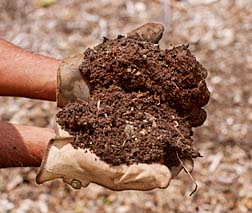Advertisement - Click to support our sponsors.


Dig This
![]()
Friday, April 7, 2000

By Dennis Oda , Star-Bulletin
Urban Garden Center volunteer Ralph Lee opens the lid
of an easy-to-rotate homemade compost bin, above.
As Earth Day approaches on April 22, many gardeners can feel good about their efforts. Giving back to
the EarthThe gardener beautifies the environment and contributes to better air quality. Hydroponic and xeriscapic gardeners do this while conserving water. And composters do it while diverting waste from landfills and creating homemade fertilizer for their plants.
A brochure on backyard composting produced by the University of Hawaii College of Tropical Agriculture and Human Resources estimates that the amount of garbage placed on the curb by the average family can be reduced by 75 percent through composting and recycling glass, aluminum and paper.
And be not afraid, composting at home is not nearly as difficult, smelly or space-consuming as you might think.
"Composting is simple," said Henry Gabriel, a recycling specialist with the City & County of Honolulu who teaches backyard recycling.
BACKYARD COMPOSTING
CTAHR brochure: Call 956-7046 or stop by Gilmore Hall, Room 119, UH Manoa campus
Class: 9:30-11 a.m. May 20 at Ho'omaluhia Botanical Garden. Call 233-7323
While compost heaps are the traditional solution -- toss everything in a corner of the yard and shovel it around every couple of weeks -- container composting is better suited to an urban lifestyle.
Commercial composting bins are sold in garden shops and catalogs, but all you really need is an old 35-gallon plastic garbage can with holes drilled in the sides for air and the bottom for drainage.
Compost requires water, and it will likely get enough from the waste you deposit. Other key ingredients are oxygen, let in by the holes drilled in compost containers; carbon, which comes from things like tree mulch, sawdust (from untreated wood only), white paper and newspaper; nitrogen from grass clippings, aquatic plants, produce trimmings, leafy garden trimmings and other kitchen scraps like coffee grounds; and decomposing organisms, which will find the compost if you've done your part well.
"Compost in general should not stink," said Gabriel.
Stinky compost can be caused by a lack of oxygen or poor drainage, so don't forget those holes. Some organic waste -- oils, dairy products and animal waste, flesh, bones or shells (with the exception of egg shells) -- also can create stinky compost and should not be included.
Other organic materials you should avoid composting are weeds and diseased plants as they can wreak havoc on your garden if they are not adequately decomposed.

Both passive and active composting methods will work, according to Gabriel, active methods simply produce faster results.The difference is in how much time you devote to the process.
If you simply toss stuff in the can and shake the contents around occasionally, it will produce compost eventually, with the stuff on the bottom being ready first. If you turn the compost every couple of weeks, that means dumping the can out and shoveling everything back in, the process will proceed much more quickly.
Another way to "turn" compost is to have more than one bin. When one fills, dump its contents into the next. Or you can make a rotating compost bin.
The one pictured here was designed by an Urban Garden Center volunteer, according to Dale Sato, project coordinator at the Pearl City garden.
A PVC pipe goes through the plastic barrel and serves as its axis. Larger pipes and fittings are used to make the frame. The door is cut from the side of the barrel and reattached with hinges and hook and eye fasteners. The barrels are used commercially to store soft drink syrup, among other things. Oils of Aloha (637-5620) sells used barrels when they are available.
If you'd like to inspect this compost bin, the Urban Garden Center is open 9 a.m. to 2 p.m. Mondays through Fridays.
Gabriel has been composting for seven years and finds the end result of the process rewarding.
"You're putting (nutrients) back into your garden. You keep (garbage) out of the waste stream. We live on an island. Landfill space is valuable," he said.
Gabriel's next class is May 20 at Ho'omaluhia Botanical Garden and he plans to teach classes at both Ho'omaluhia and the Urban Garden Center over the summer.
Gardening Calendar in Do It Electric!
Stephanie Kendrick's gardening column runs Fridays in Today.
You can write her at the Star-Bulletin, P.O. Box 3080, Honolulu 96802
or email skendrick@starbulletin.com